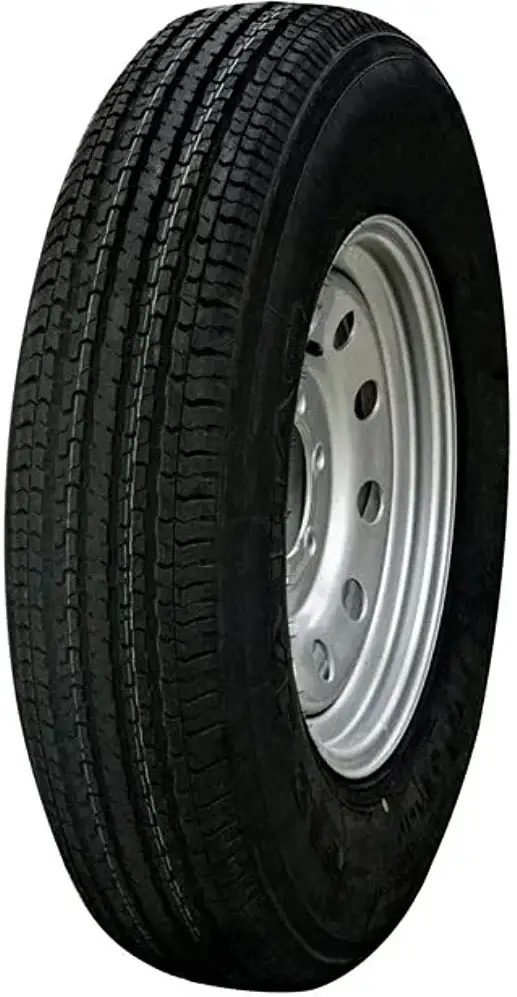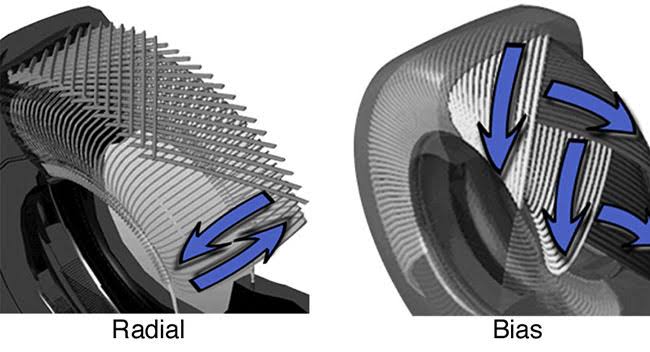Are you struggling to find replacement tires for your vehicle with the uncommon 9.50-16.5 tire size? If so, then converting to a more common tire size would be the solution.
So, how do you do 9.50-16.5 tire conversion?
The metric conversion of the 9.50-16.5 bias-ply tire is 241/75R16.5 with an aspect ratio of 75%. Here ‘R’ stands for ‘Radial’. However, this size is not available anymore. The closest metric sizes to this tire size are 245/75R16, 235/75R16, 235/80R16, and 235/85R16.
This tire conversion guide will help you determine compatible sizes and improve your driving experience. Keep reading!
9.50-16.5 Tire Conversion: A Comprehensive Guide
9.50-16.5 is a bias ply tire in which, the first number, 9.50, represents the tire width in inches. Also, the second number, 16.5, represents the diameter of the wheel in inches.
The 9.50-16.5 tire size is an old and uncommon size that was commonly used on heavy-duty vehicles such as trucks and trailers. However, as the automotive industry has evolved, this tire size has become harder to find, and replacement options are limited.
That’s why we are here to help you out to convert your 9.50-16.5 tire to a more available size as we did in 6.50 16 tire conversion.
Metric Sized Radial Tire Conversion for 9.50-16.5 Tire:
Modern vehicles use metric-sized radial tires as original equipment. Radial tires usually have information printed on their side that tells you their size, which is usually given in metric units. This information includes the tire’s width, aspect ratio, and diameter.
So, let’s convert 9.50-16.5 tires into metric sized radials.
Step 1: Determine The Section Width of The Tire in Millimeters
The section width of a tire refers to the measurement of the tire’s width from one sidewall to the other sidewall across the tire’s cross-section. As your tire is labeled as 9.50-16.5, then the section width of this tire is 9.50 inches.
So, let’s convert the section width to millimeters by simply multiplying it by 25.4(1 inches = 25.4 millimeters):
Section width = 9.50 inches x 25.4 = 241.3 mm.
Step 2: Determine The Aspect Ratio of The Tire
The aspect ratio of a tire is the height of its sidewall compared to its section width, expressed as a percentage. In this case, we will take a 75% aspect ratio as it is common in 9.50-16.5 tires.

Step 3: Determine The Sidewall Height
To determine the sidewall height, we have to multiply the section width in millimeters by the aspect ratio (in decimal form):
So, the aspect ratio in decimal would be 75 / 100 = 0.75
Sidewall height = 241.3 mm x 0.75 = 181.0 mm
Therefore, the sidewall height of the 9.50-16.5 tire is 181.0 mm.
Step 4: Determine The Rim Diameter
For the 9.50-16.5 tire, we get the rim size 16.5 inches.
Now, let’s convert the rim diameter to millimeters by multiplying it by 25.4:
Rim diameter in millimeters = 16.5 inches x 25.4 = 419.1 mm
Step 5: Find The Metric Equivalent of 9.50-16.5 Tire
We have determined the sidewall width aspect ratio and rim diameter. Therefore, the metric equivalent of a 9.5-16.5 tire with a 75 aspect ratio is approximately 241/75R16.5, where “R” stands for “radial.”
Step 6: Find The Closest Metric Tire Sizes for 9.50-16.5 Tire
241/75R16.5 size tires are not available. So, we have to find the closest metric tire sizes. Let’s use a tire size conversion chart or calculator to find the closest metric tire sizes. We will do this step based on the section width, aspect ratio, sidewall height, and rim diameter we have calculated from steps 1 to 4.
Here is a table showing the tire size of 9.50-16.5 in metric form that we have calculated from step 1 to 4.
| Tire Parameter | Metric Measurements |
| Overall Diameter | 777.24 mm |
| Section Width | 241.3 mm |
| Sidewall Height | 181.0 mm |
| Rim Diameter | 419.1 mm |
After examining the available tire size options and studying the corresponding charts, we can suggest some metric tire sizes that are similar to the original 9.50-16.5 tire sizes. These tire sizes include 245/75R16, 235/75R16, 235/80R16 and 235/85R16.
Here is a table showing details about 245/75R16, 235/75R16, 235/80R16 and 235/85R16 tires.
| Tire | Overall Diameter | Section Width | Sidewall Height | Rim Diameter |
| 245/75R16 | 774 mm | 245 mm | 184 mm | 406 mm |
| 235/75R16 | 758 mm | 235 mm | 176 mm | 406 mm |
| 235/80R16 | 782 mm | 235 mm | 188 mm | 406 mm |
| 235/85R16 | 806 mm | 235 mm | 200 mm | 406 mm |
Although these metric sizes are slightly different from the original 9.50-16.5 tire size, they are suitable replacements.
It is essential to note that for proper fit and performance, it is best to choose a tire size recommended by the vehicle manufacturer when replacing tires.
Step 7: Check The Compatibility Of The New Tire
Check the load index and speed ratings of the new tire. 9.60-16.5 tires commonly have a load index of 121. The load index of the new tire should match or exceed the original tire’s load capacity rating.
The speed rating should also match or exceed the original tire’s rating to prevent any potential safety hazards. Generally, 9.50-16.5 tires have speed ratings up to 75 mph. Additionally, ensure that the tire fits properly on the wheel by checking the bead diameter.
Also, It is important to take into account the compatibility between the rim and tire when making a decision, as they must be suitable for each other. For instance, before using a 305 mm tire on a 10 inch rim, it is important to determine whether they are compatible.
Ultimately, before making the final decision, you have to make sure that the new tire is compatible with your vehicle.
Tire Installation Cost:
The prices of 245/75R16, 235/75R16, 235/80R16, and 235/85R16 tires can vary widely, usually between $50 to $300 per tire. But the higher end tires will cost you more. The cost of each tire largely depends on its specific size and the brand that produces it.

On the other hand, the cost of installation can vary depending on your service provider. It usually ranges from $15 to $45 per tire.
Bias Ply Tires Vs Radial Tires:

As you are converting your tire from bias ply to radial, let’s see what are the key differences between them like we did in Flat Tire vs Deflated Tire.
- Construction: Bias ply tires have overlapping plies at an angle, while radial tires have plies that run perpendicular to the tread.
- Durability: Bias ply tires are stronger and more durable than radial tires, but less flexible.
- Comfort: Radial tires offer a more comfortable ride than bias ply tires, due to their flexible construction.
- Performance: Radial tires provide better handling, cornering, and braking performance compared to bias ply tires.
- Heavy-duty applications: Bias ply tires are better suited for heavy-duty applications, such as on construction vehicles or farm equipment.
- Cost: Bias ply tires are typically less expensive than radial tires.
- Contact patch: Radial tires have a larger contact patch with the road surface, providing better grip and traction compared to bias ply tires.
So, before changing your tires you should consider these differences between bias ply and radial tires.
Frequently Asked Questions (FAQs):
Can I Change Tire Size on The Same Rim?
Yes, it is possible to change the size of tires on the same rim as long as the new tires are suitable for the wheel’s width. However, it’s important to ensure that the larger tires have enough clearance inside the wheel to avoid any potential issues.
Will the new tire size affect my speedometer reading?
Yes, changing the tire size can affect your speedometer reading. Larger, taller tires may cause the speedometer to display slower than actual speed. That’s why we will recommend you to recalibrate the speedometer for accurate readings.
What Size Tire Can I Substitute?
When you’re looking for substitute tires, find tires that are no more than 3% larger or smaller in diameter than your current tires. This rule assumes that you’re using the tires recommended in your owner’s manual. It’s a good idea to stick to this guideline to ensure that your vehicle’s performance and handling remain optimal.
Conclusion
To conclude, this 9.50-16.5 tire conversion guide helps you to convert your old tire size to more commonly available metric sizes. You can determine the equivalent metric tire size by following the steps we have outlined.
Remember to check the load index and speed ratings, and ensure proper fit before making a final decision. Good luck!
